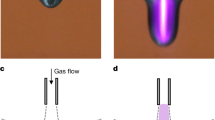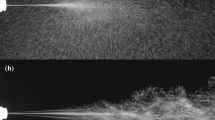Abstract
When a liquid is subject to a sufficiently strong electric field, it can be induced to emit thin fluid jets from conical tip structures that form at its surface. Such behaviour has both fundamental and practical implications, from raindrops in thunderclouds to pendant drops in electrospray mass spectrometry. But the large difference in length scales between these microscopic/nanoscopic jets and the macroscopic drops and films from which they emerge has made it difficult to model the electrohydrodynamic (EHD) processes that govern such phenomena. Here, we report simulations and experiments that enable a comprehensive picture of the mechanisms of cone formation, jet emission and break-up that occur during EHD tip streaming from a liquid film of finite conductivity. Simulations show that EHD tip streaming does not occur if the liquid is perfectly conducting or perfectly insulating, and enable us to develop a scaling law to predict the size of the drops produced from jet break-up.
This is a preview of subscription content, access via your institution
Access options
Subscribe to this journal
Receive 12 print issues and online access
$209.00 per year
only $17.42 per issue
Buy this article
- Purchase on Springer Link
- Instant access to full article PDF
Prices may be subject to local taxes which are calculated during checkout




Similar content being viewed by others
References
Gilbert, W. De Magnete (Dover, 1958) (First published in Latin in 1600 and translated by P. F. Mottelay in 1893).
Zeleny, J. Instability of electrified liquid surfaces. Phys. Rev. 10, 1–6 (1917).
Taylor, G. I. Disintegration of water drops in an electric field. Proc. R. Soc. Lond. A 280, 383–397 (1964).
Cloupeau, M. & Prunet-Foch, B. Electrostatic spraying of liquids in cone-jet mode. J. Electrostat. 22, 135–159 (1989).
Achtzehn, T., Müller, R. & Leisner, T. The Coulombic instability of charged microdroplets: Dynamics and scaling. Eur. Phys. J. D 34, 311–313 (2005).
Fenn, J., Mann, M., Meng, C., Wong, S. & Whitehouse, C. Electrospray ionization for mass-spectrometry of large biomolecules. Science 246, 64–71 (1989).
Ptasinski, K. J. & Kerkhof, P. J. A. M. Electric-field driven separations—phenomena and applications. Sep. Sci. Technol. 27, 995–1021 (1992).
Harris, M. T., Scott, T. C. & Byers, C. H. The synthesis of metal hydrous oxide particle by multiphase electrodispersion. Mater. Sci. Eng. A 168, 125–129 (1993).
Barrero, A. & Loscertales, I. Micro- and nanoparticles via capillary flows. Annu. Rev. Fluid Mech. 39, 89–106 (2007).
Fernández de la Mora, J. The fluid dynamics of Taylor cones. Annu. Rev. Fluid Mech. 39, 217–243 (2007).
Mestel, A. J. The electrohydrodynamic cone-jet at high Reynolds number. J. Aerosol Sci. 25, 1037–1047 (1994).
Shtern, V. & Barrero, A. Striking features of fluid-flows in Taylor cones related to electrosprays. J. Aerosol Sci. 25, 1049–1063 (1994).
Fernández de la Mora, J. F. & Loscertales, I. The current emitted by highly conducting Taylor cones. J. Fluid Mech. 260, 155–184 (1994).
Gañán-Calvo, A. M. Cone-jet analytical extension of Taylor’s electrostatic solution and the asymptotic universal scaling laws in electrospraying. Phys. Rev. Lett. 79, 217–220 (1997).
Gañán-Calvo, A. M., Dávila, J. & Barrero, A. Current and droplet size in the electrospraying of liquids. Scaling laws. J. Aerosol Sci. 28, 249–275 (1997).
Cherney, L. T. Electrohydrodynamics of electrified liquid menisci and emitted jets. J. Aerosol Sci. 30, 851–862 (1999).
Higuera, F. Flow rate and electric current emitted by a Taylor cone. J. Fluid Mech. 484, 303–327 (2003).
Gañán-Calvo, A. M. On the general scaling theory for electrospraying. J. Fluid Mech. 507, 203–212 (2004).
López-Herrera, J. M., Gañán-Calvo, A. M. & Perez-Saborid, M. One-dimensional simulation of the breakup of capillary jets of conducting liquids. Applications to E.H.D. spraying. J. Aerosol Sci. 30, 895–912 (1999).
López-Herrera, J. M. & Gañán-Calvo, A. M. A note on charged capillary jet breakup of conducting liquids: Experimental validation of a viscous one-dimensional model. J. Fluid Mech. 501, 303–326 (2004).
Collins, R. T. Deformation and Breakup of Liquid Films, Jets and Drops in Electric Fields. Thesis, Purdue Univ. (2007).
Melcher, J. R. & Taylor, G. I. Electrohydrodynamics: a review of the role of interfacial shear stresses. Annu. Rev. Fluid Mech. 1, 111–146 (1969).
Saville, D. A. Electrohydrodynamics: The Taylor–Melcher leaky dielectric model. Annu. Rev. Fluid Mech. 29, 27–64 (1997).
Chen, A. U., Notz, P. K. & Basaran, O. A. Computational and experimental analysis of pinch-off and scaling. Phys. Rev. Lett. 88, 4501 (2002).
Suryo, R. & Basaran, O. A. Tip streaming from a liquid drop forming from a tube in a co-flowing outer fluid. Phys. Fluids 18, 082102 (2006).
Notz, P. K. & Basaran, O. A. Dynamics of drop formation in an electric field. J. Colloid Interface Sci. 213, 218–237 (1999).
Reznik, S. N., Yarin, A. L., Theron, A. & Zussman, E. Transient and steady shapes of droplets attached to a surface in a strong electric field. J. Fluid Mech. 516, 349–377 (2004).
Zubarev, N. M. Formation of conic cusps at the surface of liquid metal in electric field. JETP Lett. 73, 544–548 (2001).
Eggers, J. Universal pinching of 3D axisymmetric free-surface flow. Phys. Rev. Lett. 71, 3458–3460 (1993).
Lister, J. R. & Stone, H. A. Capillary breakup of a viscous thread surrounded by another viscous fluid. Phys. Fluids 10, 2758–2764 (1998).
Hayati, I., Bailey, A. I. & Tadros, T. F. Mechanism of stable jet formation in electrohydrodynamic atomization. Nature 319, 41–43 (1986).
Gamero-Castaño, M. & Hruby, V. Electric measurements of charged sprays emitted by cone-jets. J. Fluid Mech. 459, 245–276 (2002).
Grimm, R. & Beauchamp, J. Dynamics of field-induced droplet ionization: Time-resolved studies of distortion, jetting, and progeny formation from charged and neutral methanol droplets exposed to strong electric fields. J. Phys. Chem. B 109, 8244–8250 (2005).
Marín, A., Loscertales, I., Marquez, M. & Barrero, A. Simple and double emulsions via coaxial jet electrosprays. Phys. Rev. Lett. 98, 014502 (2007).
Gañán-Calvo, A. M. Electro-flow focusing: The high-conductivity low-viscosity limit. Phys. Rev. Lett. 98, 134503 (2007).
Taylor, G. I. & McEwan, A. D. The stability of a horizontal fluid interface in a vertical electric field. J. Fluid Mech. 22, 1–15 (1965).
Oddershede, L. & Nagel, S. R. Singularity during the onset of an electrohydrodynamic spout. Phys. Rev. Lett. 85, 1234–1237 (2000).
Acknowledgements
This work was supported by the Shreve Trust Fund at Purdue University and the BES Program of US DOE.
Author information
Authors and Affiliations
Contributions
R.T.C.: theoretical and numerical work, article writing; J.J.J.: experimental work; M.T.H.: project planning; O.A.B.: theoretical work, project planning, article writing.
Corresponding author
Rights and permissions
About this article
Cite this article
Collins, R., Jones, J., Harris, M. et al. Electrohydrodynamic tip streaming and emission of charged drops from liquid cones. Nature Phys 4, 149–154 (2008). https://doi.org/10.1038/nphys807
Received:
Accepted:
Published:
Issue Date:
DOI: https://doi.org/10.1038/nphys807
This article is cited by
-
A Review on the Recent Development of Carbon Nanotubes (CNTs) Application for Polymeric Mixed-Matrix Membranes: Synthesis, Performance, and Future Challenges
Journal of Inorganic and Organometallic Polymers and Materials (2024)
-
Active self-assembly of piezoelectric biomolecular films via synergistic nanoconfinement and in-situ poling
Nature Communications (2023)
-
Electrospun Flexible Nanofibres for Batteries: Design and Application
Electrochemical Energy Reviews (2023)
-
Stabilization of liquid instabilities with ionized gas jets
Nature (2021)
-
Trajectory analysis of the charged droplet during electrohydrodynamic jet printing
Microsystem Technologies (2021)



